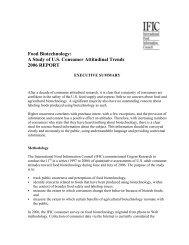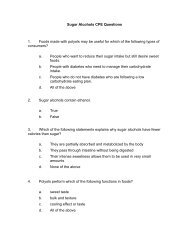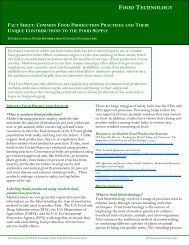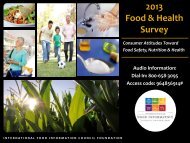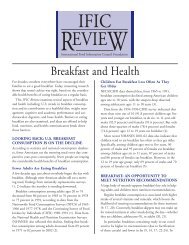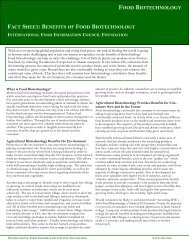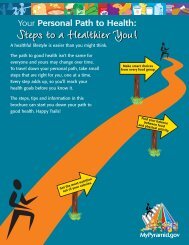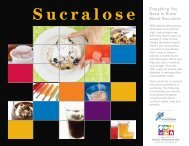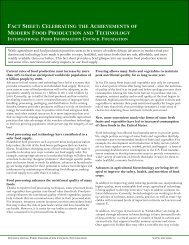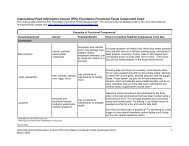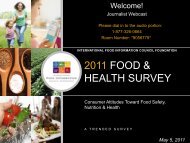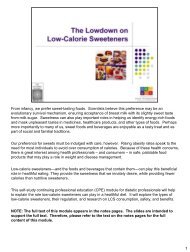PDF of the slides - International Food Information Council Foundation
PDF of the slides - International Food Information Council Foundation
PDF of the slides - International Food Information Council Foundation
Create successful ePaper yourself
Turn your PDF publications into a flip-book with our unique Google optimized e-Paper software.
Welcome!<br />
Please dial in to <strong>the</strong> audio portion:<br />
(800) 658-3095<br />
Access Code: 964856914#
Today’s s Speakers<br />
• Jennifer Schleman, APR<br />
Director, Public Outreach and Online Communications<br />
<strong>International</strong> <strong>Food</strong> <strong>Information</strong> <strong>Council</strong> <strong>Foundation</strong><br />
• Tony Flood<br />
Director, <strong>Food</strong> Safety Communications <strong>International</strong><br />
<strong>Food</strong> <strong>Information</strong> <strong>Council</strong> <strong>Foundation</strong><br />
• Robert “Bob” Gravani, PhD<br />
Pr<strong>of</strong>essor <strong>of</strong> <strong>Food</strong> Science, Cornell University<br />
• Diane Van<br />
Manager, USDA Meat and Poultry Hotline<br />
Please dial in to <strong>the</strong> audio portion: (800) 658-3095<br />
Access Code: 964856914#<br />
2009 <strong>Food</strong> & Health Survey
Agenda<br />
• Brief Background<br />
• Presentation <strong>of</strong> Findings<br />
• Pathogens that Cause <strong>Food</strong>borne Illness<br />
• Practical Tips for Consumers<br />
• Questions and Answers<br />
– Submit your questions via email to<br />
foodandhealth@ific.org<br />
• Twitter hashtag: #foodsafety<br />
Please dial in to <strong>the</strong> audio portion: (800) 658-3095<br />
Access Code: 964856914#<br />
2009 <strong>Food</strong> & Health Survey
<strong>International</strong> <strong>Food</strong> <strong>Information</strong><br />
<strong>Council</strong> <strong>Foundation</strong><br />
Mission:<br />
To effectively communicate science-<br />
based information on health, nutrition,<br />
and food safety for <strong>the</strong> public good.<br />
Primarily supported by <strong>the</strong> broad-based<br />
based<br />
food, beverage and agricultural industries.<br />
http://www.ific.org<br />
Please dial in to <strong>the</strong> audio portion: (800) 658-3095<br />
Access Code: 964856914#<br />
2009 <strong>Food</strong> & Health Survey
The <strong>Foundation</strong> <strong>Food</strong> & Health Survey<br />
http://www.ific.org<br />
2006<br />
2007<br />
2008<br />
2009<br />
2009 <strong>Food</strong> & Health Survey
Methodology<br />
Methodology<br />
Web Survey<br />
Population Representative Sample <strong>of</strong> Americans Aged 18+<br />
Data Collection Period February 19-March 11, 2009<br />
Sample Size (Error)<br />
Data Weighting*<br />
n=1,064<br />
(+ 3.0 for 2009)<br />
(+ 4.4 among 2009, 2008, 2007, 2006)<br />
Data Weighted on Age, Gender, Income, Education and<br />
Race<br />
*Weighting is a widely accepted statistical technique that is used to ensure that <strong>the</strong><br />
distribution <strong>of</strong> <strong>the</strong> sample reflects that <strong>of</strong> <strong>the</strong> population on key demographics. With any data<br />
collection method, even when <strong>the</strong> outgoing sample is balanced to <strong>the</strong> Census, some<br />
populations are more likely than o<strong>the</strong>rs to respond.<br />
/ Significant increase/decrease from year indicated<br />
2009 <strong>Food</strong> & Health Survey
Taste Still <strong>the</strong> Number One<br />
Factor Influencing Purchases;<br />
Price Increases to an All-Time High<br />
Taste<br />
34%<br />
53%<br />
87%<br />
Price<br />
31%<br />
43%<br />
74%<br />
’06<br />
‘07/’06<br />
Healthfulness<br />
35%<br />
26%<br />
61%<br />
Convenience<br />
26%<br />
26%<br />
52%<br />
’07<br />
’06<br />
Some Impact<br />
Great Impact<br />
How much <strong>of</strong> an impact do <strong>the</strong> following have on your decision to buy foods and beverages<br />
(n=1064)<br />
/ Significant increase/decrease from year indicated<br />
2009 <strong>Food</strong> & Health Survey
Sources <strong>of</strong> <strong>Information</strong> Guiding<br />
<strong>Food</strong> Safety and Health Practices<br />
<strong>Food</strong> label 61%<br />
Friends/family 42%<br />
Health pr<strong>of</strong>essional 33%<br />
Grocery store, drug store, or specialty<br />
store 28%<br />
Magazine article 28%<br />
Internet article 27%<br />
TV news program 24%<br />
Product or manufacturer communications 13%<br />
Newspaper 13%<br />
Health association 9%<br />
Dietitian 8%<br />
Government <strong>of</strong>ficial/agency 5%<br />
Radio news program 3%<br />
Blog or social networking site 1%<br />
O<strong>the</strong>r 4%<br />
What three sources <strong>of</strong> information do you use most <strong>of</strong>ten to guide your food, nutrition,<br />
and food safety practices Select three. (n=1064)<br />
/ Significant increase/decrease from year indicated<br />
2009 <strong>Food</strong> & Health Survey
<strong>Information</strong> Used on <strong>the</strong><br />
<strong>Food</strong> and Beverage Package<br />
Nutrition Facts panel<br />
69%<br />
Expiration date<br />
Brand name<br />
Ingredients list<br />
Size <strong>of</strong> product<br />
67%<br />
50% ’08/’07/’06<br />
49%<br />
43% ’08/’06<br />
Statements about health benefits<br />
Country <strong>of</strong> origin labeling<br />
Organic**<br />
Allergen labeling<br />
Health symbol or health icon<br />
20%<br />
17%<br />
’06<br />
13%<br />
’08/’07<br />
11%<br />
10%<br />
None <strong>of</strong> <strong>the</strong> above<br />
6%<br />
What information do you look for on <strong>the</strong> food or beverage package when deciding to purchase or<br />
eat a food or beverage Select all that apply. (n=1064)<br />
/ Significant increase/decrease from year indicated<br />
2009 <strong>Food</strong> & Health Survey
FOOD SAFETY<br />
Confidence in <strong>the</strong> Safety <strong>of</strong> <strong>the</strong> U.S. <strong>Food</strong><br />
Supply<br />
Safe <strong>Food</strong> Preparation<br />
Please dial in to <strong>the</strong> audio portion: (800) 658-3095<br />
Access Code: 964856914#<br />
Please submit your questions via email to<br />
foodandhealth@ific.org
Perceived Responsibility for <strong>the</strong><br />
Safety <strong>of</strong> <strong>the</strong> U.S. <strong>Food</strong> Supply<br />
<strong>Food</strong> manufacturers<br />
73%<br />
Government<br />
72%<br />
Farmers/producers<br />
57%<br />
Retailers/food service<br />
49%<br />
Consumers/individuals<br />
41%<br />
In general, who do you believe is responsible for food safety in <strong>the</strong> U.S. Select all that apply.<br />
(n=1064)<br />
NOTE: “O<strong>the</strong>r” response (one percent) not shown<br />
/ Significant increase/decrease from year indicated<br />
2009 <strong>Food</strong> & Health Survey
Person-on<br />
on-<strong>the</strong>-Mall Speaks….<br />
“Everyone has to do <strong>the</strong>ir<br />
part to make sure that <strong>the</strong><br />
process from plant to<br />
consumer is a good one<br />
and a safe one”<br />
View this video and o<strong>the</strong>rs at: http://www.ific.org/videos/Index.cfm<br />
2009 <strong>Food</strong> & Health Survey
Confidence in <strong>the</strong> Safety<br />
<strong>of</strong> <strong>the</strong> U.S. <strong>Food</strong> Supply<br />
Please dial in to <strong>the</strong> audio portion: (800) 658-3095<br />
Access Code: 964856914#<br />
Please submit your questions via email to<br />
foodandhealth@ific.org
Nearly Half <strong>of</strong> Consumes are<br />
Confident in <strong>the</strong> Safety <strong>of</strong> <strong>the</strong><br />
U.S. <strong>Food</strong> Supply.<br />
Not very<br />
confident<br />
20%<br />
Nei<strong>the</strong>r<br />
confident nor<br />
unconfident<br />
26%<br />
Not at all<br />
confident<br />
5%<br />
Extremely or<br />
somewhat<br />
confident<br />
49%<br />
To what extent, if at all, are you confident in <strong>the</strong> safety <strong>of</strong> <strong>the</strong> U.S. food supply (n=1064)<br />
/ Significant increase/decrease from year indicated<br />
2009 <strong>Food</strong> & Health Survey
<strong>Food</strong>borne Illness is Perceived as <strong>the</strong><br />
Most Important <strong>Food</strong> Safety Issue.<br />
<strong>Food</strong><br />
allergens<br />
2%<br />
Imported<br />
foods<br />
10%<br />
Chemicals<br />
in food<br />
30%<br />
O<strong>the</strong>r<br />
2%<br />
Don't<br />
know<br />
6%<br />
<strong>Food</strong>borne<br />
illnesses<br />
from<br />
bacteria<br />
52%<br />
What, in your opinion, is <strong>the</strong> most important food safety issue today Select one. (n=1064)*<br />
*Total does not add to 100% due to rounding<br />
/ Significant increase/decrease from year indicated<br />
2009 <strong>Food</strong> & Health Survey
Safe <strong>Food</strong> Preparation<br />
Please dial in to <strong>the</strong> audio portion: (800) 658-3095<br />
Access Code: 964856914#<br />
Please submit your questions via email to<br />
foodandhealth@ific.org
Fewer Americans are Taking<br />
<strong>Food</strong> Safety Precautions to<br />
Reduce Their Risk<br />
Wash my hands with soap and water<br />
Wash cutting board(s) with soap and water or<br />
bleach<br />
’08<br />
87%<br />
77% ’08<br />
Cook to required temperature (such as 165<br />
degrees F for poultry<br />
Properly store leftovers within 2 hours <strong>of</strong> serving<br />
Separate raw meat, poultry and seafood from<br />
ready-to-eat food products<br />
71% ’08<br />
69% ’08<br />
63% ’08<br />
Use different or freshly cleaned cutting boards for<br />
each product (such as raw meat/poultry/produce)<br />
50%<br />
Use a food <strong>the</strong>rmometer to check <strong>the</strong> doneness <strong>of</strong><br />
meat and poultry items<br />
25%<br />
None <strong>of</strong> <strong>the</strong> above<br />
5%<br />
Which <strong>of</strong> <strong>the</strong> following actions do you perform regularly when cooking, preparing, and consuming<br />
food products Select all that apply. (n=1064)<br />
/ Significant increase/decrease from year indicated<br />
2009 <strong>Food</strong> & Health Survey
Fewer Consumers Adhering to Some<br />
Safe Microwave Cooking Practices<br />
Follow ALL <strong>the</strong> cooking instructions<br />
Flip, rotate, or stir during <strong>the</strong> microwave cooking process<br />
Check <strong>the</strong> meal package label at point <strong>of</strong> purchase to<br />
determine if <strong>the</strong> product is suitable for microwave cooking<br />
Let food stand for appropriate time after microwaving<br />
Increase or decrease cooking times based on my<br />
microwave<br />
Check microwave wattage<br />
Use a food <strong>the</strong>rmometer to make sure <strong>the</strong> food reaches <strong>the</strong><br />
required temperature<br />
None <strong>of</strong> <strong>the</strong> above<br />
’08<br />
’08<br />
’08<br />
’08<br />
I do not have or use a microwave<br />
’08<br />
Which <strong>of</strong> <strong>the</strong> following actions do you perform regularly when preparing microwavable meals (e.g.,<br />
frozen meals, pre-packaged meals that contain cooking instructions) at home Select all that apply.<br />
(n=1064)<br />
/ Significant increase/decrease from year indicated<br />
2009 <strong>Food</strong> & Health Survey
The Majority <strong>of</strong> Americans<br />
do not Perceive Any Obstacles<br />
to Handling <strong>Food</strong> Safely.<br />
What obstacles, if any, do you face when handling food safely Select all that apply. (n=1064)<br />
NOTE: “O<strong>the</strong>r” response (one percent) not shown<br />
/ Significant increase/decrease from year indicated<br />
2009 <strong>Food</strong> & Health Survey
A Call to Action<br />
• Increase awareness about general food<br />
safety practices<br />
– Re-introduce <strong>the</strong> food safety basics<br />
– Understand and communicate <strong>the</strong> risks <strong>of</strong><br />
foodborne illness<br />
• Identify target audiences to receive food<br />
safety education<br />
• Work in concert with all stakeholders to<br />
communicate about food safety risks<br />
– Consumers<br />
– Industry<br />
– Government<br />
– Academics<br />
– Retailers<br />
Please dial in to <strong>the</strong> audio portion: (800) 658-3095<br />
Access Code: 964856914#<br />
Please submit your questions via email to<br />
foodandhealth@ific.org<br />
2009 <strong>Food</strong> & Health Survey
Risks <strong>of</strong> <strong>Food</strong>borne Illness<br />
By<br />
Robert B. Gravani, Ph.D.<br />
Department <strong>of</strong> <strong>Food</strong> Science<br />
Cornell University
Today’s consumers<br />
are more concerned<br />
about food quality<br />
and safety than ever<br />
before !
<strong>Food</strong>borne Illness in <strong>the</strong> U.S.<br />
Every year foodborne illnesses result in<br />
an estimated:<br />
• 76 Million cases <strong>of</strong> illness<br />
• 325,000 people hospitalized<br />
• 5,000 needless deaths each year<br />
• Economic losses ~ $10 - $83 Billion<br />
Sources: CDC & <strong>Food</strong> Code
<strong>Food</strong>borne Illness in <strong>the</strong> U.S.<br />
What do <strong>the</strong>se numbers really mean<br />
• 1 in 4 Americans will develop<br />
foodborne illness<br />
• 1 in 1000 people will be hospitalized<br />
due to <strong>the</strong> symptoms <strong>of</strong> foodborne<br />
illnesses
<strong>Food</strong>borne Outbreaks, 2007<br />
Confirmed<br />
Etiology<br />
Bacterial<br />
Chemical<br />
Parasitic<br />
Viral<br />
No. Outbreaks<br />
257<br />
34<br />
5<br />
199<br />
No. Cases<br />
6,410<br />
141<br />
65<br />
6,120
<strong>Food</strong>borne Outbreaks, 2007<br />
All Etiologies<br />
Total Confirmed<br />
Total Suspected<br />
Unknown<br />
Grand Total<br />
No. Outbreaks<br />
507<br />
226<br />
362<br />
1097<br />
No. Cases<br />
13,138<br />
2,944<br />
5,079<br />
21,183
Bacterial Pathogens <strong>of</strong> concern<br />
*Salmonella<br />
*Listeria<br />
*E. coli O157:H7
Viral <strong>Food</strong>borne Pathogens<br />
*Norovirus<br />
*Hepatitis A
Factors Affecting <strong>the</strong> Number<br />
<strong>of</strong> <strong>Food</strong>borne Illnesses<br />
• Increases in elderly and<br />
chronically ill persons<br />
• Changes in consumer practices:<br />
awareness <strong>of</strong> hazards, risks and hygiene<br />
• Changes in eating habits<br />
• <strong>International</strong> travel<br />
• Globalization <strong>of</strong> <strong>the</strong> food industry
Supply Chain Complexity<br />
Kennedy, 2007
Cheeseburger Supply Chain<br />
baking soda<br />
wheat gluten<br />
calcium propionate<br />
enzymes<br />
bleached wheat flour mono- and diglycerides<br />
malted barley flour diacetyl tartaric acid esters<br />
thiamine<br />
ethanol<br />
rib<strong>of</strong>lavin<br />
sorbitol<br />
Niacin polysorbate 20<br />
folic acid<br />
potassium propionate<br />
reduced iron<br />
sodium stearoyl lactylate<br />
Water<br />
corn starch<br />
corn syrup<br />
ammonium chloride<br />
sesame seeds<br />
ammonium sulfate<br />
soybean oil<br />
calcium peroxide<br />
Yeast<br />
ascorbic acid<br />
Salt<br />
azodicarbonamide<br />
calcium sulfate<br />
calcium carbonate<br />
calcium silicate<br />
soy flour<br />
lettuce<br />
dehydrated onions<br />
Grill Seasonings<br />
Salt<br />
Pepper<br />
cottonseed oil<br />
soybean oil<br />
Milk<br />
milkfat<br />
Water cream<br />
sodium citrate salt<br />
sodium phosphate sorbic acid<br />
artificial color cheese culture<br />
acetic acid soy lecithin<br />
Enzymes<br />
starch<br />
Special Sauce<br />
Soybean oil pickles<br />
distilled vinegar water<br />
egg yolks<br />
HF corn syrup<br />
sugar<br />
onion powder<br />
corn syrup spice<br />
spice extractives salt<br />
xanthan gum mustard flour<br />
prop. glycol alginate sodium benzoate<br />
potassium sorbate mustard bran<br />
garlic powder hydrolyzed proteins<br />
caramel color paprika<br />
Turmeric<br />
calcium disodium<br />
EDTA<br />
USDA inspected beef<br />
Cucumbers<br />
water<br />
Vinegar<br />
Salt<br />
calcium chloride<br />
Alum<br />
Natura lflavorings<br />
polysorbate 80<br />
turmeric<br />
Kennedy, 2007
Factors Affecting <strong>the</strong> Number<br />
<strong>of</strong> <strong>Food</strong>borne Illnesses<br />
• Changes in food processing technologies<br />
• Improved diagnostics and medical advances<br />
• Increases in food prepared outside<br />
<strong>the</strong> home: multiple handling <strong>of</strong> food<br />
• Changes in microorganisms:<br />
Microbial Evolution
Changes in Microorganisms<br />
• Fewer cells needed to<br />
cause illness & some <strong>of</strong><br />
<strong>the</strong> illness are more severe<br />
• Severe complications can result<br />
• Adaptation to environmental conditions
The Cycle <strong>of</strong> Infection<br />
HOSTS<br />
PATHOGENS<br />
ENVIRONMENT
Factors Increasing <strong>the</strong> Risk <strong>of</strong><br />
<strong>Food</strong>borne Infection or <strong>the</strong><br />
Severity <strong>of</strong> Illness<br />
Microbial<br />
Host<br />
Environmental<br />
CAST, 1994
Microbial Factors<br />
• Type and strain <strong>of</strong> pathogen ingested<br />
* Some pathogens & strains are<br />
more virulent than o<strong>the</strong>rs<br />
• Quantity <strong>of</strong> pathogens ingested<br />
* High numbers ingested may increase<br />
severity <strong>of</strong> illness &/or shorten onset<br />
time<br />
CAST, 1994
Host Factors<br />
• Age less than 5 years<br />
* Lack <strong>of</strong> developed immune system<br />
* Smaller infective dose-by-weight required<br />
• Age greater than 50 or 60 years<br />
(depending on pathogen)<br />
* Immune systems failing;<br />
weakened by chronic illnesses<br />
CAST, 1994
Host Factors<br />
• Pregnancy<br />
* Altered immunity during pregnancy<br />
• Hospitalized persons<br />
* Individuals already debilitated by illness<br />
• Concomitant Infections<br />
CAST, 1994
Host Factors<br />
• Immuno-compromised individuals…<br />
including those on chemo<strong>the</strong>rapy or<br />
radiation <strong>the</strong>rapy; recipients <strong>of</strong> organ<br />
transplants taking immunocompromising<br />
drugs; persons with<br />
leukemia, AIDS,<br />
or o<strong>the</strong>r illnesses CAST, 1994
Persons with AIDS and<br />
Late-Stage HIV<br />
• Salmonellosis<br />
*20 times higher risk<br />
*6 times more likely to develop<br />
life-threatening blood disease<br />
• Listeriosis<br />
*200-300 times higher risk<br />
*25% <strong>of</strong> cases end in death<br />
FDA
Environmental Factors<br />
• Geographic location<br />
* Exposure to virulent strains <strong>of</strong> pathogens<br />
* Varied distribution <strong>of</strong> organisms in<br />
water, food & soil<br />
CAST, 1994
Reducing <strong>Food</strong>borne Illness through<br />
Prevention<br />
Production<br />
Processing<br />
Distribution<br />
and<br />
Storage<br />
Transportation<br />
Consumers<br />
Retail<br />
Preparation<br />
Consumption<br />
Regulations, Enforcement, and Guidance<br />
Illness <br />
Education Training Surveillance<br />
Research<br />
Adapted from
Reducing <strong>Food</strong>borne Illness through<br />
Prevention<br />
Production<br />
Processing<br />
Distribution<br />
and<br />
Storage<br />
Transportation<br />
Consumers<br />
Retail<br />
Preparation<br />
Consumption<br />
Regulations, Enforcement, and Guidance<br />
Illness <br />
Education Training Surveillance<br />
Research<br />
Adapted from
The End
<strong>Food</strong> Safety<br />
Thrives<br />
When You Focus<br />
on<br />
5<br />
Diane Van, Manager<br />
USDA Meat and Poultry<br />
Hotline<br />
Please dial in to <strong>the</strong> audio portion: (800) 658-3095<br />
Access Code: 964856914#<br />
Please submit your questions via email to<br />
foodandhealth@ific.org
Three major causes <strong>of</strong> foodborne illness<br />
in <strong>the</strong> United States are<br />
-- Not cooking food to a safe temperature.<br />
-- Holding food at an unsafe temperature.<br />
-- Lack <strong>of</strong> hand washing.<br />
The mission <strong>of</strong> USDA’s <strong>Food</strong> Safety and<br />
Inspection Service (FSIS) is to protect <strong>the</strong> health<br />
<strong>of</strong> Americans and prevent foodborne illness.<br />
<strong>Food</strong> Safety Thrives When You Focus on Five
1. Purchasing<br />
2. Cooking<br />
3. Holding<br />
4. Separating<br />
5. Cleaning<br />
Please dial in to <strong>the</strong> audio portion: (800) 658-3095<br />
Access Code: 964856914#<br />
Please submit your questions via email to<br />
foodandhealth@ific.org
1<br />
Purchasing<br />
1<br />
<strong>Food</strong> Safety Thrives When You Focus on Five
Buy Refrigerated Perishables<br />
Make sure meat, poultry and seafood<br />
products -- whe<strong>the</strong>r raw, pre-packaged, packaged, or<br />
from <strong>the</strong> deli -- are refrigerated when<br />
purchased.<br />
Purchase meat, poultry, seafood and o<strong>the</strong>r<br />
perishable products last. Keep packages <strong>of</strong><br />
raw meat, poultry and seafood separate<br />
from o<strong>the</strong>r foods,<br />
particularly foods that will be eaten without<br />
fur<strong>the</strong>r cooking.<br />
1<br />
<strong>Food</strong> Safety Thrives When You Focus on Five
No Dents<br />
Canned goods should be free <strong>of</strong><br />
dents, cracks or bulging lids.<br />
1<br />
<strong>Food</strong> Safety Thrives When You Focus on Five
Go Directly Home<br />
Plan to drive directly home from <strong>the</strong> grocery<br />
store. You may want to take a cooler with ice<br />
for perishables. Always refrigerate perishable<br />
food within 2 hours. Refrigerate within 1 hour<br />
when <strong>the</strong> temperature is above 90 °F.<br />
1<br />
<strong>Food</strong> Safety Thrives When You Focus on Five
Cooking<br />
2<br />
2<br />
<strong>Food</strong> Safety Thrives When You Focus on Five
S.M.I.T.<br />
Always cook to<br />
“Safe Minimum Internal Temperatures.”<br />
If harmful bacteria are present, only thorough<br />
cooking will destroy <strong>the</strong>m.<br />
Freezing or rinsing <strong>the</strong> foods in cold water is not<br />
sufficient to destroy bacteria.<br />
2<br />
<strong>Food</strong> Safety Thrives When You Focus on Five
Use a <strong>Food</strong> Thermometer<br />
to determine if your meat,<br />
poultry or casserole has<br />
reached a safe minimum<br />
internal temperature. Check<br />
<strong>the</strong> product in several spots to<br />
assure that a safe<br />
temperature has been<br />
reached.<br />
Color is not a reliable indicator<br />
<strong>of</strong> safely cooked foods.<br />
2<br />
<strong>Food</strong> Safety Thrives When You Focus on Five
When Microwaving <strong>Food</strong>s<br />
• Carefully follow manufacturers<br />
instructions.<br />
• Know your microwave wattage.<br />
Wattage makes a difference in<br />
<strong>the</strong> amount <strong>of</strong> time needed to<br />
cook food to a safe internal<br />
temperature.<br />
• Use microwave-safe containers,<br />
cover, rotate, and allow for <strong>the</strong><br />
standing time, which<br />
contributes to thorough<br />
cooking.<br />
2<br />
<strong>Food</strong> Safety Thrives When You Focus on Five
3<br />
Holding<br />
<strong>Food</strong> Safety Thrives<br />
3<br />
When You Focus on Five
Holding<br />
Hold hot foods at or above<br />
140 °F and cold foods 40 °F<br />
or below.<br />
Keep hot food hot with<br />
chafing dishes, slow cookers,<br />
and warming trays.<br />
<strong>Food</strong> Safety Thrives<br />
3<br />
When You Focus on Five
Keep <strong>Food</strong> Cold<br />
• Nest dishes in beds <strong>of</strong> ice.<br />
• Or use a series <strong>of</strong> small<br />
serving trays and replace<br />
<strong>the</strong>m <strong>of</strong>ten. Replace empty<br />
platters — don’t t refill <strong>the</strong>m.<br />
• Discard food that has been<br />
sitting out and may have<br />
been handled by many<br />
people.<br />
<strong>Food</strong> Safety Thrives<br />
3<br />
When You Focus on Five
Don’t t Leave <strong>Food</strong> Out<br />
Never leave foods, raw or<br />
cooked, at room<br />
temperature longer than<br />
2 hours.<br />
On a hot day with<br />
temperatures above<br />
90 °F, , this decreases to<br />
1 hour.<br />
<strong>Food</strong> Safety Thrives<br />
3<br />
When You Focus on Five
Reheat Keep <strong>Food</strong> to 165 Cold<br />
°F<br />
Do not use chafing dishes, slow<br />
cookers, and warming trays<br />
for reheating. They're just for<br />
maintaining <strong>the</strong> reheated<br />
temperature.<br />
Make sure to reheat foods to<br />
at least 165 °F.<br />
Bring soups, sauces and gravies<br />
to a rolling boil.<br />
<strong>Food</strong> Safety Thrives<br />
3<br />
When You Focus on Five
4<br />
Separating<br />
<strong>Food</strong> Safety Thrives When You<br />
4<br />
Focus on Five
Cross-contamination<br />
Cross-contamination is <strong>the</strong><br />
transfer <strong>of</strong> harmful bacteria to<br />
a food from o<strong>the</strong>r foods,<br />
cutting boards, utensils,<br />
surfaces, or hands. Prevent it<br />
by keeping food separated and<br />
by keeping hands, utensils, and<br />
food handling surfaces clean.<br />
<strong>Food</strong> Safety Thrives When You<br />
4<br />
Focus on Five
Cross-contamination<br />
Use one<br />
cutting board<br />
for fresh<br />
produce —<br />
and a separate<br />
one for raw<br />
meat, poultry,<br />
and seafood.<br />
<strong>Food</strong> Safety Thrives When You<br />
4<br />
Focus on Five
Separate<br />
Separate foods in<br />
your grocery cart.<br />
Keep raw meat,<br />
poultry, seafood, and<br />
<strong>the</strong>ir juices away from<br />
o<strong>the</strong>r food to fur<strong>the</strong>r<br />
prevent <strong>the</strong> possibility<br />
<strong>of</strong> cross-<br />
contamination.<br />
Separar<br />
Limpiar <strong>Food</strong> Safety Thrives When You<br />
Cocinar<br />
4<br />
Focus on Five
5<br />
Cleaning<br />
5<br />
<strong>Food</strong> Safety Thrives When You Focus on Five
Cleaning<br />
Always wash hands with soap and<br />
warm water for 20 seconds<br />
• Before beginning food<br />
preparation,<br />
• After handling food, and<br />
• After using <strong>the</strong> bathroom,<br />
changing diapers, or touching<br />
pets.<br />
Not washing hands is a major cause <strong>of</strong> foodborne illness.<br />
5<br />
<strong>Food</strong> Safety Thrives When You Focus on Five
Wash<br />
•Wash counters, equipment,<br />
utensils, and cutting boards with<br />
soap and hot water immediately<br />
after use.<br />
•Sanitize with a chlorine solution<br />
<strong>of</strong> 1 tablespoon <strong>of</strong> unscented,<br />
liquid chlorine bleach in 1 gallon <strong>of</strong><br />
water.<br />
•Let <strong>the</strong> solution stand on <strong>the</strong><br />
board after washing, or follow <strong>the</strong><br />
instructions on sanitizing products.<br />
5<br />
<strong>Food</strong> Safety Thrives When You Focus on Five
Protect Your Family<br />
• PURCHASE<br />
• COOK<br />
• CHILL<br />
• SEPARATE<br />
• CLEAN<br />
<strong>Food</strong> Safety Thrives<br />
When You Focus on Five<br />
1 2 3 4 5
Call <strong>the</strong> USDA<br />
Meat & Poultry Hotline<br />
Send E-mail questions to MPHotline.fsis@usda.gov.<br />
If you have a question<br />
about meat, poultry, or egg products,<br />
call <strong>the</strong> USDA Meat and Poultry Hotline<br />
toll free at<br />
1-888-MPHotline<br />
(1-888-674-6854)<br />
The Hotline is open year-round Monday<br />
through Friday from 10 a.m. to 4 p.m.<br />
ET (English or Spanish).<br />
Recorded food safety messages are<br />
available 24 hours a day. Check out <strong>the</strong><br />
FSIS Web site at<br />
www.fsis.usda.gov.<br />
<strong>Food</strong> Safety Thrives When You Focus on Five
Ask Karen!<br />
FSIS’ automated response<br />
system can provide food safety<br />
information 24/7.<br />
Also, live “chat” now available.<br />
Look for <strong>the</strong> Spanish version <strong>of</strong><br />
“Ask Karen” in 2010.<br />
Diane Van, Manager<br />
USDA Meat and Poultry Hotline<br />
AskKaren.gov<br />
<strong>Food</strong> Safety Thrives When You Focus on Five
Questions and Answers<br />
Please submit your questions via email to<br />
foodandhealth@ific.org
Upcoming Web Casts:<br />
November: <strong>Food</strong> & Health Survey Series<br />
Part 4: “Americans’ Approach to Dieting<br />
and Weight Management Strategies”
<strong>Food</strong> & Health Survey Report<br />
Available on IFIC.org and<br />
<strong>Foundation</strong> Publications Store!<br />
The Executive Summary is available at<br />
http://www.ific.org/research/foodandhealthsurvey.cfm<br />
Full Report is available for purchase at<br />
http://www.ificpubs.org/servlet/Detailno=47<br />
Data Tables and Comparative Topline are available<br />
for purchase at<br />
http://www.ificpubs.org/servlet/Detailno=48<br />
Twitter hashtag: #foodsafety<br />
2009 <strong>Food</strong> & Health Survey
CPE Credit<br />
• Registered Dietitians can download a<br />
Certificate <strong>of</strong> Completion for ONE CPE<br />
credit at:<br />
http://www.ific.org/adacpe/2009fandhsurveycpe.cfm<br />
2009 <strong>Food</strong> & Health Survey
For more information:<br />
<strong>International</strong> <strong>Food</strong> <strong>Information</strong> <strong>Council</strong> <strong>Foundation</strong><br />
1100 Connecticut Avenue NW, Suite 430<br />
Washington, DC 20036<br />
Web: http://ific.org<br />
For inquiries: foodandhealth@ific.org



